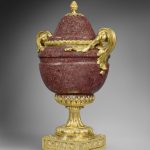An Egyptian porphyry covered vase

A late Louis XV gilt bronze-mounted Egyptian porphyry covered vase
circa 1770
The porphyry mortar 16th-17th Century
Height: 46 cm. (18 in.) Width: 29 cm. (11 ½ in.) Depth: 21.5 cm. (8 ½ in.)
Width and depth of base: 14.2 cm. (5 ½ in.)
Provenance
Collection of M. M., New York, sold Galerie Charpentier, Paris, 20 March 1959, lot 32, illustrated pl. X
Sold Ader Picard Tajan, Hôtel George V, Paris, 21 June 1989, lot 50
Comparative Literature
Similar mortar models are illustrated in D. Del Bufalo, Porphyry: Red imperial porphyry. Power and religion, Turin, 2012, p. 203.
C.Bremer-David et al., Decorative Arts: An Illustrated Summary Catalogue of the Collections of the J. Paul Getty Museum, Malibu, 1993, p. 160, no. 272.
The taste for mounting hard stones in gilt bronze begins with Louis XIV, who ordered porphyry vessels from a network of Italian suppliers and had them mounted when they arrived in France for positions of the highest prestige. At Versailles for instance, the Hall of Mirrors still to this day boasts numerous grand examples. In the 18th Century the Parisian marchands-merciers broadened this taste amongst their clientele much in same way as they did with mounted Chinese porcelain.
Great admirers included Louis XV’s last mistress, Madame du Barry, and Marc-René d’Argenson, marquis de Voyer whose Parisian hôtel particulier by the mid-1760s contained some of the first neoclassical works of French decorative art. The connoisseur-collector Augustin Blondel de Gagny’s series of sales soon after his death in 1776 were high-water marks of the history of collecting and contained numerous examples. The most celebrated collection of all was that of the duc d’Aumont, directeur des Menus-Plaisirs at his opulent hôtel particulier on the Place Louis XV (now the Hôtel Crillon, Place de la Concorde). There, the ‘à la romaine’ décor of the petit salon took direct inspiration from the duc’s collections, with the mounts on some of his vases being repeated on the wall panelling. The sale held after Aumont’s death in 1782 included several mounted hard stone objects that were acquired by Louis XVI for the future musée du Louvre.
The marchand-mercier who had this vase made started with an Egyptian porphyry mortar. He combined it with a suitable cover also in Egyptian porphyry and then had the gilt bronze mounts made by a talented Parisian bronzier, whose identity remains unknown. The result was the transformation of an already precious object into something even more desirable to collectors fascinated by antiquity.
An important design inspiration was undoubtably the collection of drawings published in 1770 by Pierre-Elisabeth de Fontanieu, Intendant and Contrôleur général des meubles de la couronne. Fontanieu’s Collection de vases inventés, et dessinés par Mr de Fontanieu “pour servir aux tourneurs et à ceux qui ornent les vases, comme fondeurs et ciseleurs“[1] contains a strikingly similar lidded vessel mounted with a finial, volute-like handles and a turned socle base (fig. 1). The genius of the marchand-mercier was to marry a porphyry mortar to this design.
The vase’s mounts can be compared with other porphyry objects adorned in gilt-bronze in Paris circa 1770 which illustrate the spread of the goùt grec. These include:
- a cup mounted on a pedestal dated 1761 in the Louvre (invs. F 783 C and OA5180)
- a potpourri vase with curved handles scrolled with acanthus leaves in the Getty Museum (Bremer-David, cit., no. 272; inv. 73.DJ.88)
- Woody’s porphyry mortar now in SF Museum
[1] Collection of vases invented and drawn by Mr de Fontanieu “to be used by turners and those who ornament vases, such as bronze founders and chasers”





